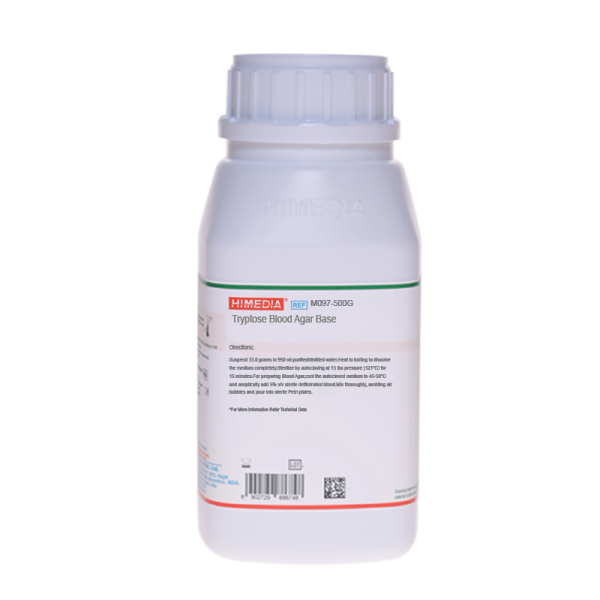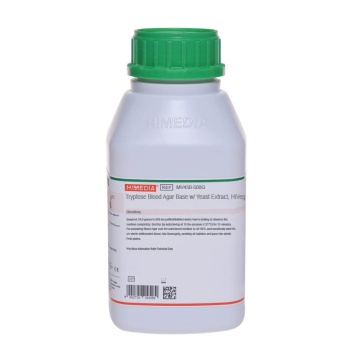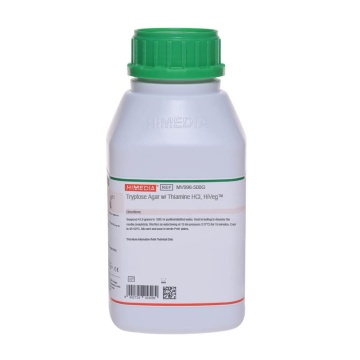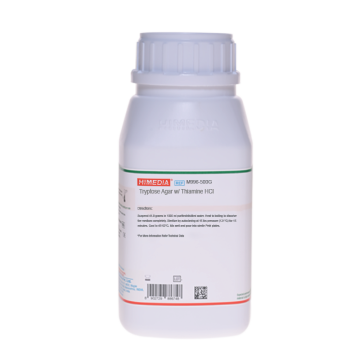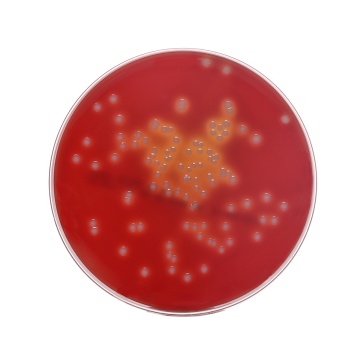 Your enquiry has been submitted
Your enquiry has been submitted
Tryptose Blood Agar Base
Francisella and Pasteurelle#CC293D
Intended Use
Recommended for the isolation of fastidious organisms and determining the haemolytic reactions.
Composition
| Ingredients | g/L |
|---|---|
| Tryptose | 10.000 |
| HM peptone B # | 3.000 |
| Sodium chloride | 5.000 |
| Agar | 15.000 |
Final pH (at 25°C): 7.2±0.2
**Formula adjusted, standardized to suit performance parameters
# - Equivalent to beef extract
Directions
Suspend 33.0 grams in 950 ml purified/distilled water.Heat to boiling to dissolve the medium completely.Sterilize by autoclaving at 15 lbs pressure (121°C) for 15 minutes. For preparing Blood Agar,cool the autoclaved medium to 45-50°C and aseptically add 5% v/v sterile defibrinated blood. Mix thoroughly, avoiding air bubbles and pour into sterile Petri plates.
Principle And Interpretation
Tryptose Blood Agar Base is a tryptose based medium that can be used for the cultivation of fastidious organisms (1,2), on supplementation with blood. This medium is devoid of dextrose and therefore useful in determining the haemolytic reactions. Tryptose Blood Agar Base is recommended by FDA (3). Tryptose Blood Agar Base can be used as a general-purpose medium without supplementation of blood. These media can be used to determine the haemolytic reactions of fastidious organisms. The four different types of hemolysis observed are as follows:
- Alpha hemolysis: partial lysis of the erythrocytes surrounding colony, causing a grey green or brownish discoloration in the media.
- Beta hemolysis: complete lysis of the red blood cells surrounding a colony, causing a clearing of blood from the medium.
- Gamma hemolysis: no hemolysis and consequently, no colour change of the medium surrounding a colony. Organisms showing no hemolysis are generally termed non-hemolytic rather than gamma haemolytic.
- Alpha-prime or wide zone alpha: a small zone of intact erythrocytes immediately adjacent to the colony, with a zone of complete red cell hemolysis surrounding the zone of intact erythrocytes. This type of hemolysis may be confused with beta hemolysis (4). Tryptose and HM peptone B provide nitrogenous and carbonaceous compounds, sulphur, vitamin B complex and trace elements essential for bacterial metabolism. Blood provides additional nutrients and serves as a base to study haemolytic reactions. This medium not only keeps the blood cells in a good state but also help in forming distinct hemolysis. Perform biochemical test for further identification (5). As per FDA BAM, pure cultures of Salmonella are maintained on Tryptose Blood Agar Base for serological testing (3).
Type of specimen
Clinical samples: Urine, skin lesions, Food samples
Specimen Collection and Handling
For food samples, follow appropriate techniques for sample collection and processing as per guidelines (3). For clinical samples follow appropriate techniques for handling specimens as per established guidelines (6,7). After use, contaminated materials must be sterilized by autoclaving before discarding.
Warning and Precautions
In Vitro diagnostic use. For professional use only. Read the label before opening the container. Wear protective gloves/ protective clothing/eye protection/face protection. Follow good microbiological lab practices while handling specimens and culture. Standard precautions as per established guidelines should be followed while handling clinical specimens. Safety guidelines may be referred in individual safety data sheets.
Limitations
- Individual organisms differ in their growth requirement and may show variable growth patterns on the medium.
- Biochemical and serological tests on colonies of pure culture is required for complete identification.
Performance and Evaluation
Performance of the medium is expected when used as per the direction on the label within the expiry period when stored at recommended temperature.
Quality Control
Appearance: Cream to yellow homogeneous free flowing powder
Gelling: Firm, comparable with 1.5% Agar gel
Colour and Clarity of prepared medium:
Basal medium: Yellow coloured clear to slightly opalescent gel forms in Petri plates. After addition of 5% v/v sterile defibrinated blood: Cherry red coloured opaque gel forms in Petri plates.
Reaction: Reaction of 3.3% w/v aqueous solution at 25°C. pH: 7.2±0.2
pH: 7.00-7.40
Cultural Response
Cultural characteristics observed with added 5% v/v sterile defibrinated blood, after an incubation at 35-37°C for 18-48 hours.
| Organism | Inoculum (CFU) | Growth w/o blood | Recovery w/o blood | Growth w/ blood | Haemolysis | Recovery w/ blood |
|---|---|---|---|---|---|---|
| Neisseria meningitidis ATCC 13090 | 50-100 | good-luxuriant | >=70% | luxuriant | none | >=70% |
| Staphylococcus aureus subsp. aureus ATCC 25923 (00034*) | 50-100 | good-luxuriant | >=70% | luxuriant | beta/gamma | >=70% |
| Staphylococcus epidermidis ATCC 12228 (00036*) | 50-100 | good-luxuriant | >=70% | luxuriant | gamma | >=70% |
| Streptococcus pneumoniae ATCC 6303 | 50-100 | fair-good | 40-50% | good | alpha | 50-70% |
| Streptococcus pyogenes ATCC 19615 | 50-100 | fair-good | 40-50% | good | beta | 50-70% |
Key: (*) Corresponding WDCM numbers.
Storage and Shelf Life
Store between 10-30°C in a tightly closed container and the prepared medium at 2-8°C. Use before expiry date on the label. On opening, product should be properly stored dry, after tightly capping the bottle in order to prevent lump formation due to the hygroscopic nature of the product. Improper storage of the product may lead to lump formation. Store in dry ventilated area protected from extremes of temperature and sources of ignition Seal the container tightly after use. Product performance is best if used within stated expiry period.
Disposal
User must ensure safe disposal by autoclaving and/or incineration of used or unusable preparations of this product. Follow established laboratory procedures in disposing of infectious materials and material that comes into contact with clinical sample must be decontaminated and disposed of in accordance with current laboratory techniques (6,7).
Reference
- Casman E. P., 1942, J. Bacteriol., 43:33.
- Casman E. P., 1947, Am. J. Clin. Pathol., 17: 281.
- Chapter 5:Salmonella, FDA Bacteriological Analytical Manual, Oct 2017, AOAC, Washington, DC.
- Koneman E. W., Allen S. D., Janda W. M., Schreckenberger P. C., Winn W. C. Jr., 1992, Colour Atlas and Textbook of Diagnostic Microbiology, 4th Ed., J. B. Lippinccott Company.
- MacFaddin J. F., 1985, Media for Isolation-Cultivation-Identification-Maintenance of Medical Bacteria, Vol. 1, Williams and Wilkins, Baltimore.
- Isenberg, H.D. Clinical Microbiology Procedures Handbook 2nd Edition.
- Jorgensen, J.H., Pfaller, M.A., Carroll, K.C., Funke, G., Landry, M.L., Richter, S.S and Warnock., D.W. (2015) Manual of Clinical Microbiology, 11th Edition. Vol. 1.
| Product Name | Tryptose Blood Agar Base |
|---|---|
| SKU | M097 |
| Product Type | Regular |
| Physical Form | Powder |
| Origin | Animal |
| Packaging type | HDPE |
| References | 1.Casman E. P., 1942, J. Bacteriol., 43:33. 2.Casman E. P., 1947, Am. J. Clin. Pathol., 17: 281. 3.FDA Bacteriological Analytical Manual, 8th Ed., 1995, AOAC International, Gaithersburg, Md. 4.American Public Health Association, 1970, Diagnostic Procedures and Reagents, 5th Ed., APHA Inc., New York. 5.MacFaddin J. F., 1985, Media for Isolation-Cultivation-Identification-Maintenance of Medical Bacteria, Vol. 1, Williamsand Wilkins, Baltimore. 6.Koneman E. W., Allen S. D., Janda W. M., Schreckenberger P. C., Winn W. C. Jr., 1992, Colour Atlas and Textbook ofDiagnostic Microbiology, 4th Ed., J. B. Lippinccott Company. |
| Customized Product Available | No |



